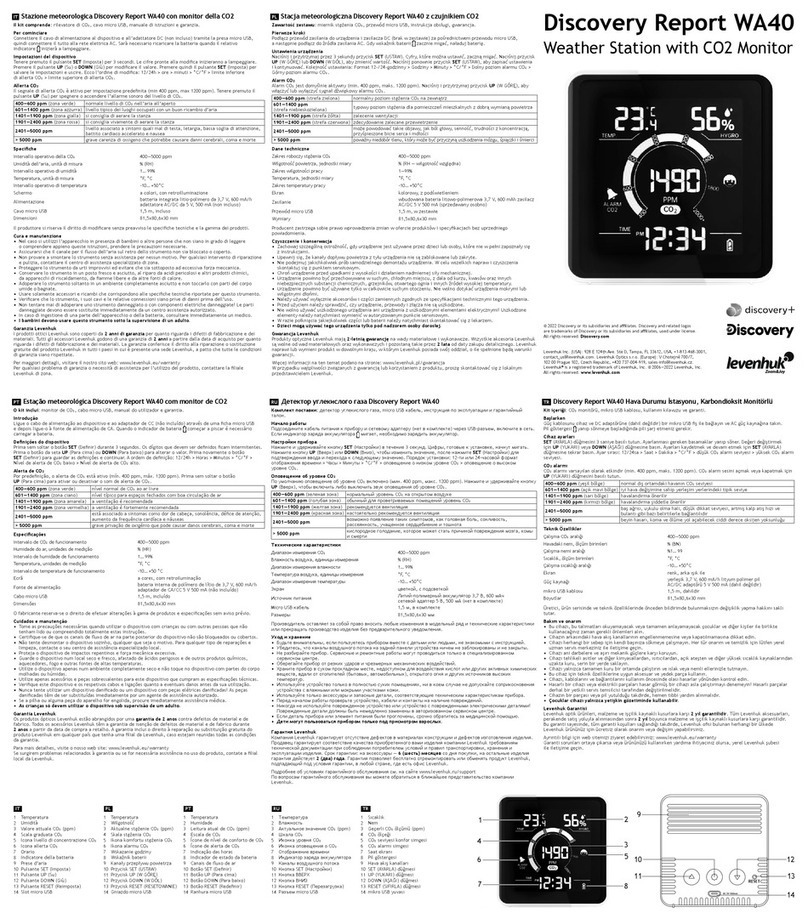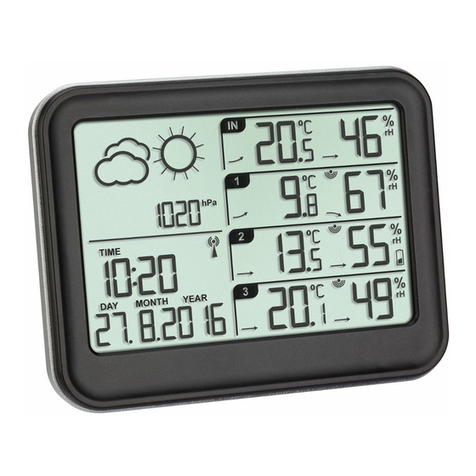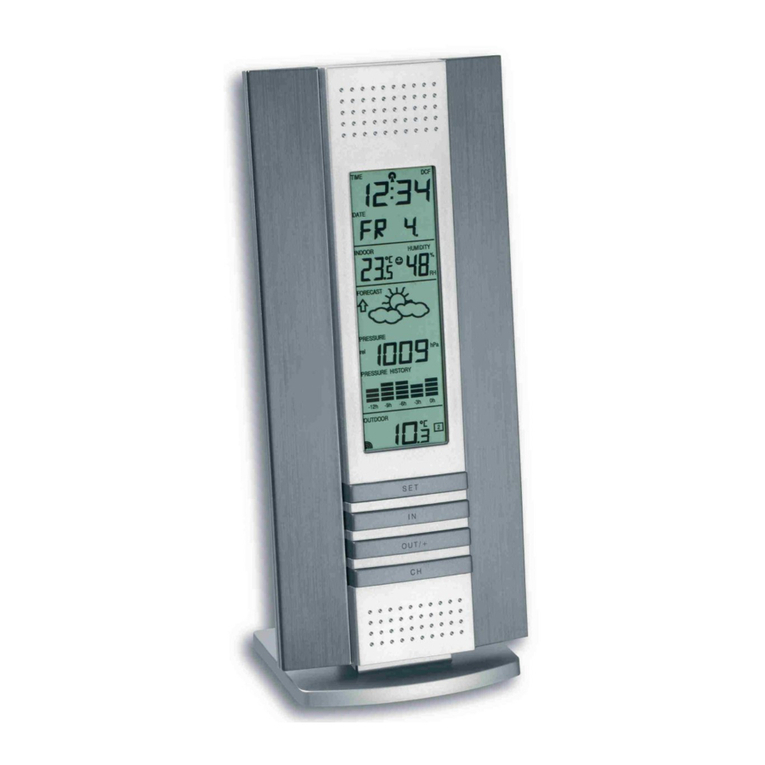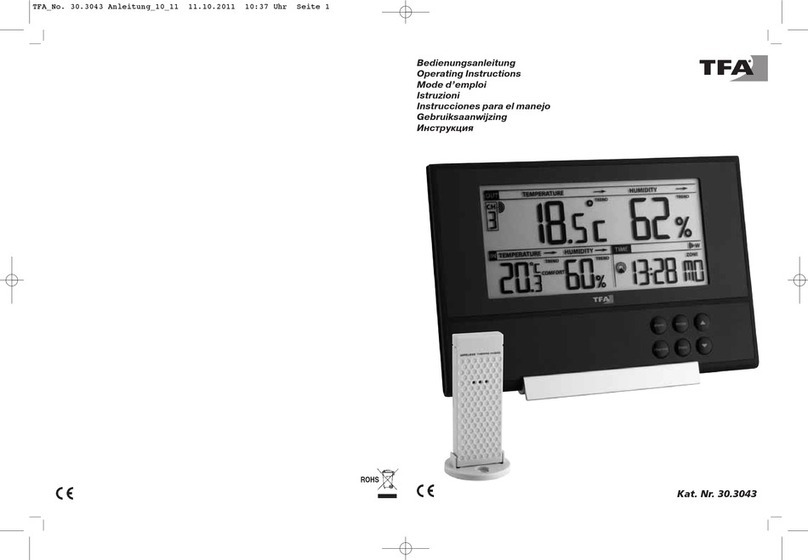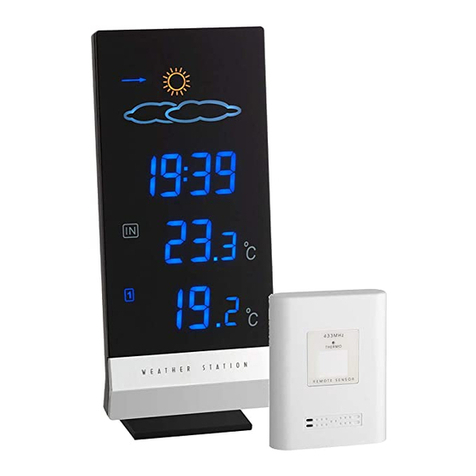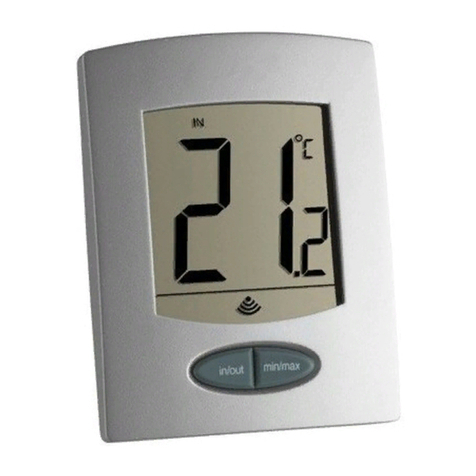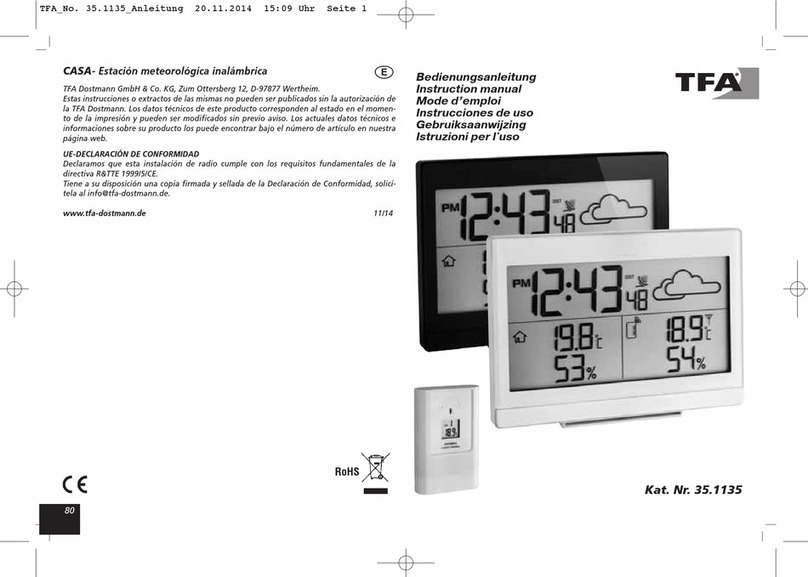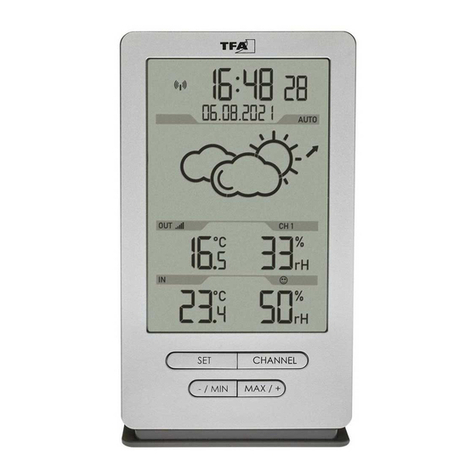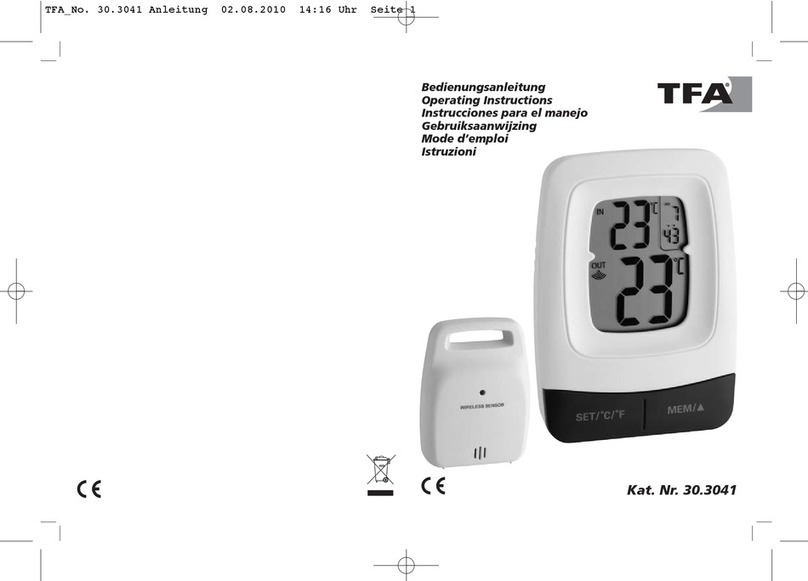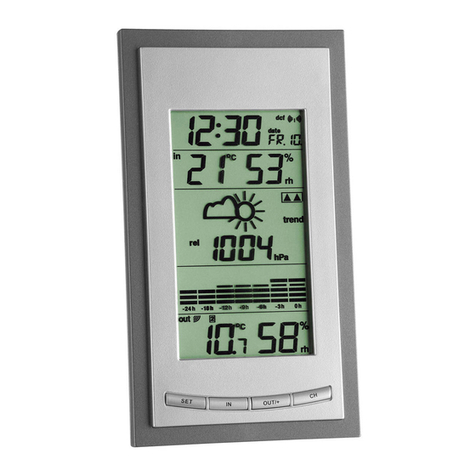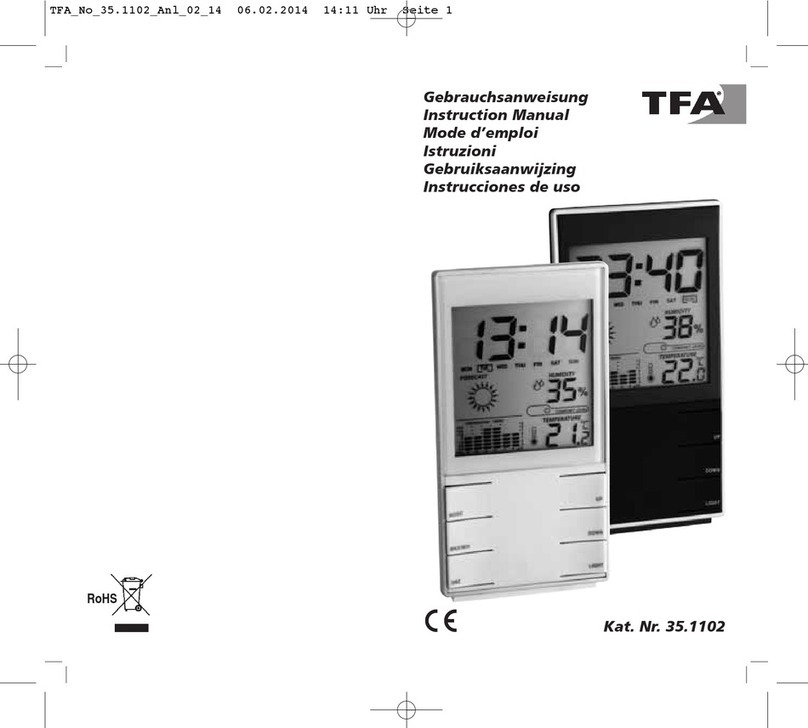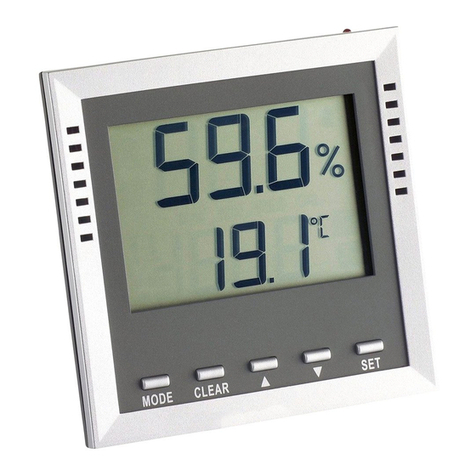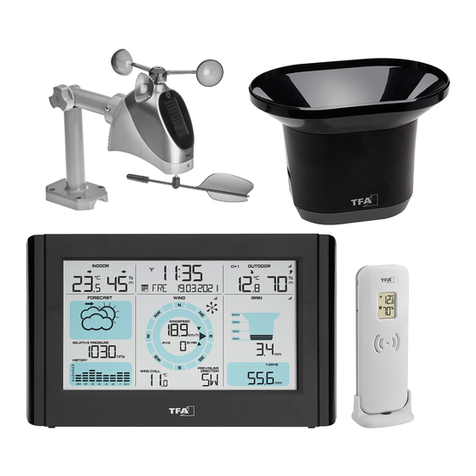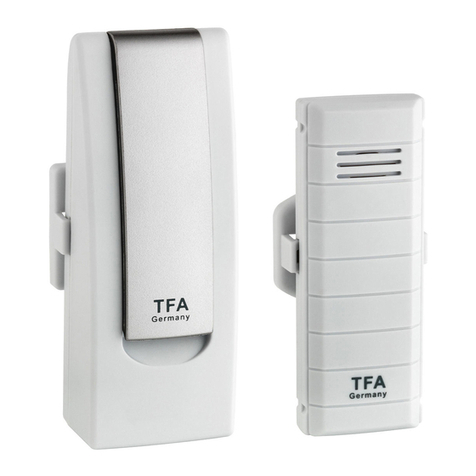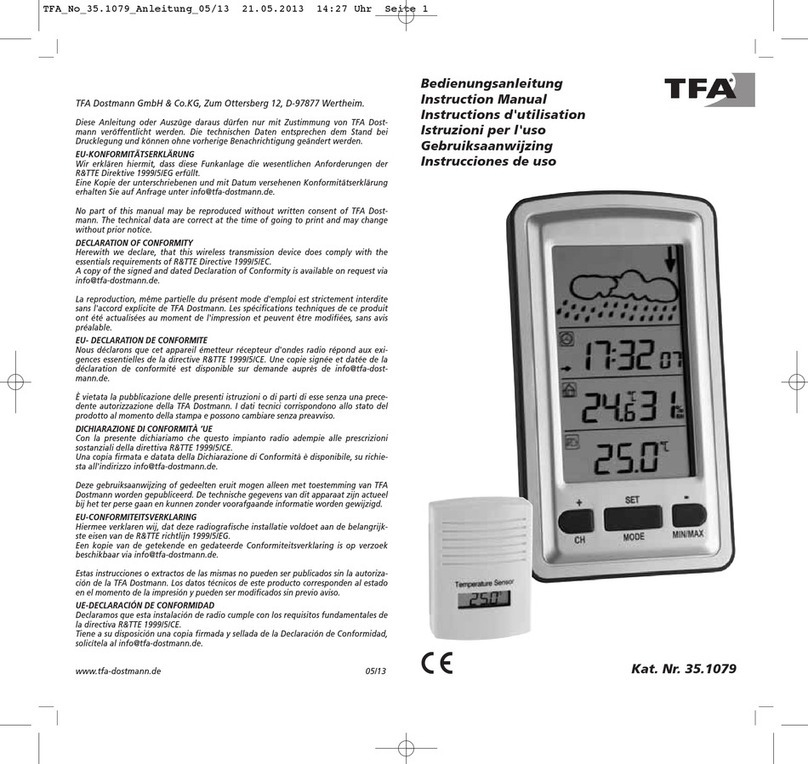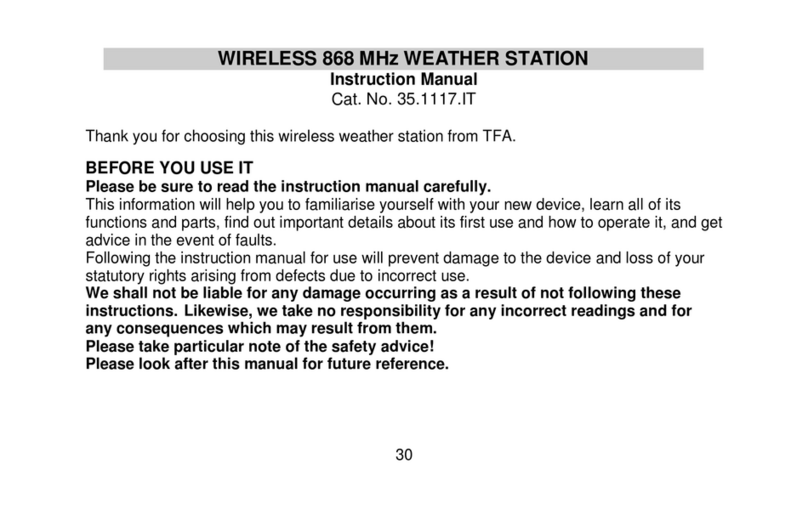SPRING – Funk-Wetterstation
8 9
• Die höchste Temperatur und Luftfeuchtigkeit für innen und außen seit der letzten Rückstellung werden
angezeigt.
• Drücken Sie die ▼Taste im Normalmodus
• MIN erscheint auf dem Display.
• Die niedrigste Temperatur und Luftfeuchtigkeit für innen und außen seit der letzten Rückstellung werden
angezeigt.
• Um wieder die Anzeige mit den aktuellen Werten zu erhalten, drücken Sie die ▲oder ▼Taste noch ein-
mal.
• Das Gerät verlässt auch automatisch den MAX/MIN-Modus, wenn keine Tasten gedrückt werden.
• Halten Sie die ▲Taste für 3 Sekunden gedrückt, während auf dem Display die höchsten Werte angezeigt
werden, um die Werte zu löschen.
• Halten Sie die ▼Taste für drei Sekunden gedrückt, während auf dem Display die niedrigsten Werte ange-
zeigt werden, um die Werte zu löschen.
• Die Höchst- und Tiefstwerte werden automatisch um Mitternacht zurückgesetzt.
7.3.2 Trendpfeile
• Die Trendpfeile zeigen Ihnen, ob die Werte für die Temperatur und Luftfeuchtigkeit aktuell steigen, fallen
oder gleich bleiben.
7.4 Wettervorhersage-Symbole
• Die Wetterstation unterscheidet 6 unterschiedliche Wettersymbole (Sonnig, teilweise bewölkt, bedeckt,
regnerisch, stürmisch und Schneefall).
• Die Vorhersage über die Symbolanzeige bezieht sich auf einen Zeitraum von 12 Stunden und gibt ledig-
lich einen Wettertrend an. Ist es zum Beispiel im Moment wolkig und es wird Regen angezeigt, deutet
dies nicht auf eine Fehlfunktion des Gerätes hin, sondern gibt an, dass der Luftdruck gesunken und eine
Wetterverschlechterung zu erwarten ist, wobei es sich aber nicht unbedingt um Regen handeln muss.
• Das Sonnensymbol wird auch bei Nacht angezeigt, wenn es sich um eine sternenklare Nacht handelt.
Wichtiger Hinweis!
• Bitte beachten Sie, dass die Symbolvorhersage sich im Laufe des Betriebs präzisiert. Die Symbolvorher-
sage ist bereits ab der Inbetriebnahme aktiv, allerdings steigt die Zuverlässigkeit der Prognosen mit der
Menge an gesammelten Daten. Der Sensor muss sich zunächst auf das Referenzniveau am Standort ein-
stellen.
• Die bestmögliche Zuverlässigkeit der Symbolvorhersage ist in der Regel nach ca. 30 Tagen gegeben.
7.5 Einstellung des Außen- und Innentemperaturalarms
• Drücken Sie die ALERTS Taste im Normalmodus.
• HIGH und 60°C (Voreinstellung) oder die zuletzt eingestellte Außentemperatur-Obergrenze wird auf dem
Display angezeigt.
• Halten Sie die ALERTS Taste gedrückt.
• Die Temperaturanzeige blinkt.
• Stellen Sie mit der ▲oder ▼Taste die gewünschte Obergrenze ein.
• Bestätigen Sie mit der ALERTS Taste.
• LOW und -40°C (Voreinstellung) oder die zuletzt eingestellte Außentemperatur-Untergrenze wird auf dem
Display angezeigt.
• Die Temperaturanzeige blinkt.
• Stellen Sie mit der ▲oder ▼Taste die gewünschte Untergrenze ein.
• Bestätigen Sie mit der ALERTS Taste.
• Stellen Sie die Ober- und Untergrenze für die Innentemperatur auf die gleiche Weise ein.
(Messbereich 0 °C… +50 °C)
7.5.1 Aktivieren und Deaktivieren des Außen- und Innentemperaturalarms
• Um die einzelnen Alarm-Funktionen zu aktivieren oder zu deaktivieren, drücken Sie die ALERTS Taste im
Normalmodus.
• HIGH und die zuletzt eingestellte Außentemperatur-Obergrenze wird auf dem Display angezeigt.
• Drücken Sie die ▲Taste, um die Alarmfunktion zu aktivieren.
• Drücken Sie die ▼Taste, um die Alarmfunktion zu deaktivieren.
SPRING – Funk-Wetterstation
• Drücken Sie die TIME SET Taste noch einmal und Sie können nun nacheinander die Spracheinstellung für
die Wochentage, das 24 – oder 12 - Stunden Anzeigeformat, die Stunden, die Minuten, das Jahr, den
Monat, den Tag und die Temperatureinheit (°C oder °F) ansteuern und mit der ▲oder ▼Taste einstellen.
• Bestätigen Sie die Eingabe mit der TIME SET Taste.
• Bei erfolgreichem Empfang des DCF-Funkempfangssignals wird die manuell eingestellte Uhrzeit über-
schrieben.
7.1.1 Einstellung der Sprachauswahl für den Wochentag
• Im Einstellungsmodus können Sie die Sprache für den Wochentag auswählen.
• Drücken Sie die ▲oder ▼Taste.
• Im Display erscheint: Deutsch - GE (Voreinstellung), Französisch - FR, Italienisch - IT, Niederländisch -
NE, Spanisch - ES, Dänisch - DA und Englisch - EN
• Bestätigen Sie die Eingabe mit der TIME SET Taste.
7.1.2 Einstellung des 24- oder 12- Stunden-Formats
• Im Einstellungsmodus können Sie zwischen dem 24 Stunden oder 12 Stunden-Format auswählen.
• Drücken Sie die ▲oder ▼Taste.
• Im 12-h-Format erscheint AM (vormittags) und PM (nachmittags) auf dem Display.
• Bestätigen Sie die Eingabe mit der TIME SET Taste.
7.1.3 Einstellung der Temperatureinheit
• Im Einstellungsmodus können Sie zwischen °C (Celsius) oder °F (Fahrenheit) als Temperatureinheit aus-
wählen.
• Drücken Sie die ▲oder ▼Taste.
• Bestätigen Sie die Eingabe mit der TIME SET Taste.
7.2 Weckalarm
• Drücken Sie die ALARM Taste.
• AL und 0:00 Uhr (Voreinstellung) oder die zuletzt eingestellte Alarmzeit erscheint auf dem Display.
• Halten Sie die ALARM Taste für 3 Sekunden gedrückt.
• Das Alarmsymbol erscheint und die Stundenanzeige fängt an zu blinken.
• Sie können mit der ▲oder ▼Taste die Stunden einstellen.
• Drücken Sie die ALARM Taste noch einmal und Sie können nun die Minuten mit der ▲oder ▼Taste ein-
stellen.
• Drücken Sie die ALARM Taste, um in den Normalmodus zurückzukehren.
• Die Alarmfunktion ist aktiviert.
• Im Display erscheint das Alarmsymbol neben der aktuellen Uhrzeit.
• Drücken Sie die ALARM Taste im Normalmodus, um die Alarmfunktion zu aktivieren oder deaktivieren.
• Im Display erscheint die eingestellte Alarmzeit und AL.
• Drücken Sie nochmals die ALARM Taste. Das Alarmsymbol erscheint oder verschwindet.
• Wenn die eingestellte Weckzeit erreicht ist, beginnt der Wecker zu klingeln.
• Das Alarmsymbol blinkt auf dem Display.
• Drücken Sie auf eine beliebige Taste und der Alarm wird beendet.
• Wird der Alarm nicht unterbrochen, schaltet sich der ansteigende Alarmton automatisch nach zwei Minu-
ten aus und aktiviert sich erneut zur gleichen Weckzeit wieder.
• Das Alarmsymbol bleibt im Display stehen.
• Wenn der Wecker klingelt, drücken Sie die SNOOZE/LIGHT (HI – LOW - OFF) Taste, um die Snooze-Funkti-
on zu aktivieren.
• Ist die Snooze-Funktion aktiviert, blinkt Zz auf dem Display.
• Der Alarm wird für die Dauer von 10 Minuten unterbrochen.
• Zum Deaktivieren der Snooze-Funktion drücken Sie die ALARM Taste.
• Das Symbol Zz verschwindet.
7.3 Temperatur und Luftfeuchtigkeit
7.3.1 Höchst- und Tiefstwerte
• Drücken Sie die ▲Taste im Normalmodus.
• MAX erscheint auf dem Display.
TFA_No. 35.1129_Anleit_12_20 22.12.2020 11:13 Uhr Seite 5

